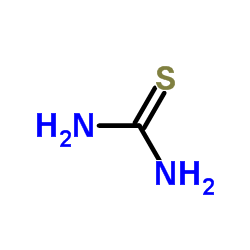Thiourea

Thiourea structure
|
Common Name | Thiourea | ||
|---|---|---|---|---|
| CAS Number | 62-56-6 | Molecular Weight | 76.121 | |
| Density | 1.405 | Boiling Point | 186.8±23.0 °C at 760 mmHg | |
| Molecular Formula | CH4N2S | Melting Point | 171-175 ºC | |
| MSDS | Chinese USA | Flash Point | 66.8±22.6 °C | |
| Symbol |



GHS07, GHS08, GHS09 |
Signal Word | Warning | |
|
Itraconazole suppresses the growth of glioblastoma through induction of autophagy: involvement of abnormal cholesterol trafficking.
Autophagy 10(7) , 1241-55, (2014) Glioblastoma is one of the most aggressive human cancers with poor prognosis, and therefore a critical need exists for novel therapeutic strategies for management of glioblastoma patients. Itraconazole, a traditional antifungal drug, has been identified as a ... |
|
|
Comparison of the antifungal efficacy of terbinafine hydrochloride and ciclopirox olamine containing formulations against the dermatophyte Trichophyton rubrum in an infected nail plate model.
Mol. Pharm. 11(7) , 1991-6, (2014) Onychomycosis is a fungal infection mostly induced by dermatophytes such as Trichophyton rubrum. Due to slow nail growth, the treatment takes 3-9 months depending on the nail size and infected area. Hence, high efficacy of the active ingredient without system... |
|
|
H4 histamine receptors inhibit steroidogenesis and proliferation in Leydig cells.
J. Endocrinol. 223(3) , 241-53, (2014) The histamine H4 receptor (HRH4), discovered only 13 years ago, is considered a promising drug target for allergy, inflammation, autoimmune disorders and cancer, as reflected by a steadily growing number of scientific publications and patent applications. Alt... |
|
|
Relationship of sperm small heat-shock protein 10 and voltage-dependent anion channel 2 with semen freezability in boars.
Theriogenology 82(3) , 418-26, (2014) Freezability differences between boar ejaculates exist, but there is no useful method to predict the ejaculate freezability before sperm cryopreservation takes place. In this context, the present study sought to determine whether the amounts of small heat-sho... |
|
|
Proteomic analysis of nasal epithelial cells from cystic fibrosis patients.
PLoS ONE 9(9) , e108671, (2014) The pathophysiology of cystic fibrosis (CF) lung disease remains incompletely understood. New explanations for the pathogenesis of CF lung disease may be discovered by studying the patterns of protein expression in cultured human nasal epithelial cells (HNEC)... |
|
|
Proteome mapping of epidermal growth factor induced hepatocellular carcinomas identifies novel cell metabolism targets and mitogen activated protein kinase signalling events.
BMC Genomics 16 , 124, (2015) Hepatocellular carcinoma (HCC) is on the rise and the sixth most common cancer worldwide. To combat HCC effectively research is directed towards its early detection and the development of targeted therapies. Given the fact that epidermal growth factor (EGF) i... |
|
|
Potential predictive plasma biomarkers for cervical cancer by 2D-DIGE proteomics and Ingenuity Pathway Analysis.
Tumour Biol. 36(3) , 1711-20, (2015) The current methods available for screening and detecting cervical squamous cell carcinoma (CSCC) have insufficient sensitivity and specificity. As a result, many patients suffered from erroneous and missed diagnosis. Because CSCC is usually asymptomatic at p... |
|
|
Evidence of histidine and aspartic acid phosphorylation in human prostate cancer cells.
Naunyn Schmiedebergs Arch. Pharmacol. 388(2) , 161-73, (2015) We have developed a method to identify previously undetected histidine and aspartic acid phosphorylations in a human prostate cancer progression model. A phosphoproteome of our cell line model is presented, with correlation of modified protein expression betw... |
|
|
Comparative proteomic analysis of fibrosarcoma and skin fibroblast cell lines.
Tumour Biol. 36(2) , 561-7, (2015) Comparative proteomic analysis of normal and cancer cell lines provides for a better understanding of the molecular mechanism of cancer development and is essential for developing more effective strategies for new biomarker or drug target discovery. The purpo... |
|
|
Comprehensive proteome analysis of the response of Pseudomonas putida KT2440 to the flavor compound vanillin.
J. Proteomics 109 , 212-27, (2014) Understanding of the molecular response of bacteria to precursors, products and environmental conditions applied in bioconversions is essential for optimizing whole-cell biocatalysis. To investigate the molecular response of the potential biocatalyst Pseudomo... |